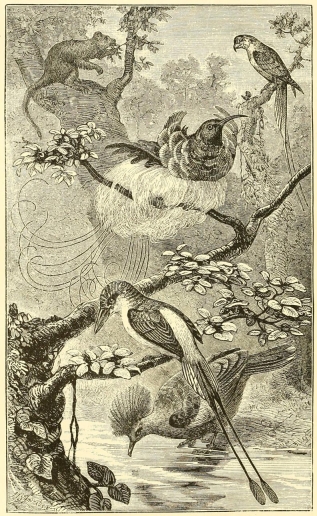Vertebrate fauna of Wallacea and surrounds
19 Ornithology of New Guinea
The following excerpt describing some of the characteristic birds (and a mammal) from New Guinea is from Wallace (1876) The Geographical Distribution of Animals, Chapter XIII. The Australian Region. p.414:
“The large central figure is the fine twelve-wired paradise-bird (Seleucides albus), one of the most beautiful and remarkable of the family… Below the Seleucides is one of the elegant racquet-tailed king-hunters (Tanysiptera galatea) whose plumage of vivid blue and white, and coral-red bill, combined with the long spatulate tail, renders this bird one of the most attractive of the interesting family of kingfishers. On a high branch is seated the little Papuan parroquet (Charmosyna papuensis), one of the Trichoglossidæ, or brush-tongued parrots,—richly adorned in red and yellow plumage, and with an unusually long and slender tail. On the ground is the well-known crowned pigeon (Goura coronata) a genus which is wholly confined to New Guinea and a few of the adjacent islands. One of the very few Papuan mammals, a tree-kangaroo (Dendrolagus inustus), is seated on a high branch. It is interesting, as an arboreal modification of a family which in Australia is purely terrestrial; and as showing how very little alteration of form or structure is needed to adapt an animal to such a different mode of life.”

Complete the following activity to check your knowledge.
Media Attributions
- Plate X Scene in New Guinea © A.R. Wallace is licensed under a Public Domain license

